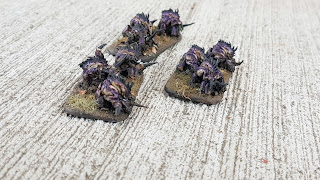Resistance Monitors
I bought these just for fun. I liked the idea with the Orbital telescope, and the kit also included bits to make the Newton Kill-Sat.
Newton Kill-Sat is equipped with a big as gun, one shot that can be target ether enemy ships or even ground targets.
The Newton was the most common pre-war naval defence monitor in the service
of mankind. Unlike modern monitors, the class is visually closer to a space station
than a ship, suiting its near-static mission profile. With the speed of the Scourge
invasion, few could manoeuvre into a firing position - unfortunate since it packs
an enormous mass driver for a frigate-sized vessel. The XN-40 “Godray” was
designed to destroy incoming targets long before they could return fire. It sits on a
swivel mount, allowing not only tracking of deep space, but precise bombardment
of surface targets. Pre-war this was largely used to quell any thoughts of
insurrection or to level inhospitable landscape prior to surface exploration.
Today, the Newton still brings incredible firepower for its cost, at the price of speed
and survivability. This gives it a valued place on the gun line of any Resistance or
Kalium admiral capable of harnessing this ship’s strengths. Although unwieldy
to bring to a forward position, its bombardment and anti-shipping firepower can
lend the class a new lease of life in an offensive role.
Galileo Orbital Telescope is my favorite, a big telescope to detect other ships. It can relay this information to nearby ships.
Galileo orbital telescopes are among the oldest human ships still flying. In the
earliest days of foldspace exploration, jumps to un-noded locations had to be
conducted in drive-wearing ‘hops’ or random inaccuracy would result. Surveying
potential jump locations for potential and celestial threats necessitated a ship
built around a gigantic, high-power scanner. Speed was unimportant, so the
superstructure of the more common Newton class monitor was chosen as an
efficient, low-cost base. Never a military vessel, the Galileo is unarmed besides
basic point defence.
Surviving Galileos were vital to stranded Resistance fleets forced to use archaic
jump-hops to seek the meagre resources not already discovered and either
captured by the Scourge or (as with the Colonies) had their node codes changed.
Being able to detect enemy activity from a vast distance is also of great use to those
small remnant fleets hiding in the cracks of the galaxy - lest they be ambushed.
At battlespace level, such observational power can be turned on in-system targets
to achieve extraordinary definition unachievable with smaller hardware. This can
augment Resistance vessels’ older scanning technology and aid a skilled captain
in targeting vulnerable spots on enemy ships.
Link to their rules:
https://cdn.shopify.com/s/files/1/0965/1274/files/Resistance_Monitors_2.0.pdf?v=1621003584
And together with my other Resistance ships I now got this small fleet.





















































